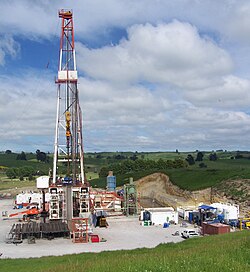Renewable energy in New Zealand
 From Wikipedia - Reading time: 9 min
From Wikipedia - Reading time: 9 min
| Part of a series on |
| Renewable energy |
|---|
 |

Approximately 44% of primary energy (Heat and power) is from renewable energy sources in New Zealand.[1] Approximately 87% of electricity comes from renewable energy,[1] primarily hydropower and geothermal power.
Renewable energy by type
[edit]Renewable electricity
[edit]Renewable electricity in New Zealand is primarily from hydropower. In 2022, 87% of the electricity generated in New Zealand came from renewable sources.[1] In September 2007, former Prime Minister Helen Clark announced a national target of 90 percent renewable electricity by 2025, with wind energy to make up much of that increase.[2]
Solar power
[edit]Solar technologies in New Zealand only became affordable alternatives in the mid-2010s, compared to previous renewable offerings. The uptake in the residential and commercial market, though slow, has increased steadily. As with all renewable options, price of generation is key to investment in the sector. It is only such changes in pricing that may see solar generation plants in the future.[3]
There is concern in New Zealand about the negative environmental impact of large-scale solar generation sites. Greenpeace Aotearoa New Zealand advocates for household solar projects to be given priority over large scale commercial projects, citing concern that commercial solar, while renewable, is not necessarily sustainable.[4] Conservation organization Forest & Bird has formally objected to a large-scale solar proposal on environmental grounds.[5]
Solar hot water
[edit]Installation of solar hot water heating systems is increasing in New Zealand due in part to government incentive schemes.[6][7]
Bioenergy
[edit]According to the New Zealand Bioenergy Association, more than 10 percent of New Zealand's energy currently comes from bioenergy.[8] Biodiesel, bioethanol and biomass (generally in the form of wood) are all used in New Zealand as a source of renewable energy.
Biomass
[edit]New Zealand is rich in biomass from wood and waste which can be used as fuel. Biomass is sourced primarily from in-forest and wood processing residues and municipal wood waste. This can be processed into pellets, chip or hog fuel.[9]
Wood fuels are sustainable and carbon-neutral[10] and can provide New Zealand with a greener economy, less dependent on fossil fuels.[11]
New Zealand Ministry of Business, Innovation and Employment data [12] shows wood fuel is the cleanest energy consumed for industrial process heat by a large margin.[13]
The Bioenergy Association of New Zealand has investigated the potential for greenhouse gas reduction brought about by switching from fossil fuel to wood biomass for industrial heat.[14] It assessed that by 2050 New Zealand could more than double 2017 biomass energy supply, providing up to 27% of NZ's energy needs and realising a 15% reduction in greenhouse gas emissions.[14]
Milk processing provides current examples of biomass use in industry:
Biomass is also used for heating in hospitals, schools and universities.[17]
Pumped Energy Storage
[edit]When the water in lakes used for hydro-electricity runs low, coal and gas fired power stations have been used to make up the shortfall.[18] In 2021, the Ardern government invested $11.5 million to investigate the feasibility of storing energy by pumping water to Lake Onslow in Central Otago. The lake could store up to 8 terawatt-hours of electricity or approximately one fifth of the country's consumption. The pumping would use power when it is plentiful and cheap, including wind power. Critics have argued that the scheme could upset the market by placing a cap on electricity prices.[19][20]
See also
[edit]References
[edit]- ^ a b c "Energy in New Zealand 2023". MBIE. August 2023.
- ^ Clark, Helen (20 September 2007). "Launch of emissions trading scheme". New Zealand Government. Retrieved 19 January 2010.
- ^ "New Zealand's cleantech future". New Zealand Herald. 30 September 2013. Retrieved 15 October 2022.
- ^ South, North &; driver, george (23 July 2023). "Solar eclipse: Our renewable power struggle". North & South Magazine. Retrieved 7 August 2024.
- ^ "Solar farm threatens MacKenzie basin | Forest and Bird". www.forestandbird.org.nz. 28 May 2024. Retrieved 7 August 2024.
- ^ "Launch of solar water heating subsidy". New Zealand Government. 25 May 2007. Retrieved 15 October 2022.
- ^ Incentives ended in 2012 "New Zealand's cleantech future". New Zealand Herald. 30 September 2013. Retrieved 15 October 2022.
- ^ "Bioenergy – the renewable fuel | Bioenergy Association of New Zealand". www.bioenergy.org.nz. Retrieved 15 September 2019.
- ^ "Information Sheet 43: Biomass fuel resource availability projections | Bioenergy Association of New Zealand". www.bioenergy.org.nz. Retrieved 15 September 2019.
- ^ "Business Scoop » Why Forestry Biomass Is Carbon Neutral". Retrieved 15 September 2019.
- ^ "The Wood Fuels Market" (PDF). Bioenergy Association of New Zealand. January 2018. Retrieved 16 September 2019.
- ^ "Process Heat – Overview". Ministry of Business, Innovation & Employment. November 2018. Retrieved 16 September 2019.
- ^ "MBIE's GHG Figures Define Clean Energy". www.scoop.co.nz. 14 November 2018. Retrieved 15 September 2019.
- ^ a b "Greenhouse gas emissions reduction using biomass energy for industrial and commercial heat" (PDF). BioEnergy Association. September 2018. Archived (PDF) from the original on 2 October 2019. Retrieved 26 April 2023.
- ^ "Fonterra's Brightwater site burns wood biomass to reduce emissions". Stuff. Retrieved 15 September 2019.
- ^ "Danone to cut carbon emissions at Balclutha plant to zero". Stuff. Retrieved 15 September 2019.
- ^ McPhee, Elena (22 June 2019). "Woodchips cleaning up Uni heating". Otago Daily Times. Retrieved 15 September 2019.
- ^ "Coal for electricity". RNZ. 11 June 2021. Retrieved 15 October 2022.
- ^ "Pumped storage". Stuff. 16 May 2022. Retrieved 15 October 2022.
- ^ "Power woes". Stuff. 9 May 2021. Retrieved 15 October 2022.
 KSF
KSF